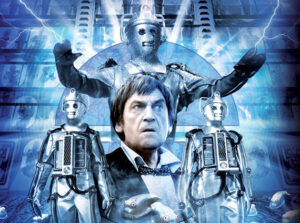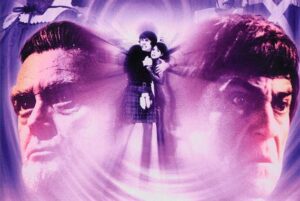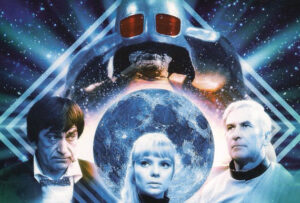The Second Doctor: Five Favourites
To celebrate Troughton’s date of birth guest contributor Francis Milan & K-Ci Williams pick out 5 of his best.

As established on many occasions amongst the concatenation of actors to play the titular role, Patrick Troughton’s second incarnation is considered the Doctor’s Doctor. Naturally, he is a great inspiration to every one of them, and, back in his day, defined the far limits of flexibility which the show could reach. Conversely different to his predecessor, the Second Doctor changed the face of Doctor Who forever; his flamboyantly nutty charm and warm affability lay the foundations for every Doctor to follow suit and make the role their own.
After all – if the role of the Second had been played by an actor of a similar age and style to William Hartnell, would the show still be the same today? Absolutely not. His character is considered by some as far more important to the show’s future than Hartnell’s original incarnation, and for good reason. With the dawn of Troughton came change – the single word which represents the overriding ethos of Doctor Who today.
The Tomb of the Cybermen
 This is, for me (K-Ci), the single most definitive story of Patrick Troughton’s era. Let’s skip straight to the sequence where the Cybermen escape their tomb; ripping through the plastic covers, climbing down the ladder-ish ladders. The scene is expertly choreographed, and it’s the image of the Second Doctor’s era that has stuck with me. It’s just so sinister; the score is paced phenomenally well, and the shock on everyone’s faces is worthy of praise. This one scene of this one story was crafted with all facets brought up to scratch.
This is, for me (K-Ci), the single most definitive story of Patrick Troughton’s era. Let’s skip straight to the sequence where the Cybermen escape their tomb; ripping through the plastic covers, climbing down the ladder-ish ladders. The scene is expertly choreographed, and it’s the image of the Second Doctor’s era that has stuck with me. It’s just so sinister; the score is paced phenomenally well, and the shock on everyone’s faces is worthy of praise. This one scene of this one story was crafted with all facets brought up to scratch.
There is a particular fascination I have with this piece of television. Everything is practically perfect. The Second Doctor himself, Mr Patrick Troughton, is superb in this story. He’s just indescribable; I very much recommend this story to any first time watchers of his era. I adore Jamie as a character as well, and the whole script is crafted spectacularly. There’s not much more to say about this, except that it made the Cybermen a whole lot scarier (in my opinion, being a modern Who kid when it was revived, the Cybermen didn’t actually make me shiver). The one story that has ever shown them close to scary and haunting is The Tomb of the Cybermen.
I must also apologise for my small contribution to this particular Five Favourites edition. It’s got something to do with my laptop breaking (Cybermen possibly did it, not able to confirm) and losing all my data of what I had previously in store for you all (they probably deleted it), but I hope to make a full tech-recovery in time for the next edition. Still, after the scare of my laptop breaking, I can confidently say… that scene from this story is quite a degree more frightening.
The Mind Robber
 There may be a little bit of imbalance on this list, considering we’ve already moved onto the Second Doctor’s final season; though what a cracking and almost untainted run of episodes it was. The Mind Robber was my [Francis, from now on] first ever favourite Classic era episode – to define it in a single word: bizarre! The Doctor, Jamie and Zoe find themselves in a land of fiction, coming face-to-face with characters such as Gulliver and a comic-book superhero. As it turns out, the whole charade is the work of super-villain the Master (though not that Master, rather annoyingly). He’s a psychological menace, which makes for some very weird and wonderful scenes – it’s realm governed by a madman, which leads to some serious havoc: people become possessed, the TARDIS trio are threatened by Medusa and the Minotaur, and there’s plenty more where that came from.
There may be a little bit of imbalance on this list, considering we’ve already moved onto the Second Doctor’s final season; though what a cracking and almost untainted run of episodes it was. The Mind Robber was my [Francis, from now on] first ever favourite Classic era episode – to define it in a single word: bizarre! The Doctor, Jamie and Zoe find themselves in a land of fiction, coming face-to-face with characters such as Gulliver and a comic-book superhero. As it turns out, the whole charade is the work of super-villain the Master (though not that Master, rather annoyingly). He’s a psychological menace, which makes for some very weird and wonderful scenes – it’s realm governed by a madman, which leads to some serious havoc: people become possessed, the TARDIS trio are threatened by Medusa and the Minotaur, and there’s plenty more where that came from.
The set design is simply sublime, from the white void to the forest, caves, and plenty of other locations explored by the Doctor. At one point, Jamie must be reassembled piece-by-piece, and the Doctor kept on clumsily misjudging parts of Jamie, which was complemented by some hilarious comic acting on Troughton’s behalf. The best stories of the Second Doctor’s era are the scripts that really push Patrick’s acting ability to the limit, and The Mind Robber is a terrific example of this.
The Invasion
 The Invasion will forever be remembered for a number of reasons. The Dawn of UNIT! The Establishment of Brigadier Lethbridge-Stewart and EverChangingMilitaryTitle Benton! And those timeless scenes of Cybermen rising from the sewers and advancing menacingly through the barren streets of London… Ach! The chills. But this wasn’t solely a Cyber-affair. (Cor, everything sounds cool with the word ‘Cyber’ in front of it, doesn’t it?) In amongst the Cyber-explosions, Cyber-guns, and cunning Cyber-plots, the Second Doctor remains as optimistically flamboyant as ever. This serial demonstrated one of Patrick’s rare stints as an action hero, albeit a reluctant one; towards the end of the story, he accompanies UNIT’s men on a Cyber-hunt. We see him dodging explosions, traversing buildings and generally running away from things.
The Invasion will forever be remembered for a number of reasons. The Dawn of UNIT! The Establishment of Brigadier Lethbridge-Stewart and EverChangingMilitaryTitle Benton! And those timeless scenes of Cybermen rising from the sewers and advancing menacingly through the barren streets of London… Ach! The chills. But this wasn’t solely a Cyber-affair. (Cor, everything sounds cool with the word ‘Cyber’ in front of it, doesn’t it?) In amongst the Cyber-explosions, Cyber-guns, and cunning Cyber-plots, the Second Doctor remains as optimistically flamboyant as ever. This serial demonstrated one of Patrick’s rare stints as an action hero, albeit a reluctant one; towards the end of the story, he accompanies UNIT’s men on a Cyber-hunt. We see him dodging explosions, traversing buildings and generally running away from things.
The visuals in this episode are truly sublime, and the story isn’t too bad either. Zoe takes charge of saving the day with her maths-y brain, which leaves the Doctor to have a whole load of fun on the front line, which was a wonderful decision by the writers. In fact, this story was originally conceived as a four-parter, before it engulfed the timeslot of another four-parter which was scrapped in early stages, giving it a total of about 200 minutes to fill! And boy, did it give a good effort at keeping the pace. Kudos must also go to chilling villain Tobias Vaughn, a superbly cast character, and the sort of adversary we could do with more of in the show these days. Cyberlicious!
The Seeds of Death
 If there’s one thing The Seeds of Death will be remembered for, it’s the triumphant return of the Ice Warriors. Which, though fantastic, is also a shame, as it brushes all of its other merits to one side. First up, there’s the terrific style of direction from Michael Ferguson: it was modern, fresh and experimental. Furthermore, the Ice Warriors’ crafty seed-pod plot resulted in some visually fantastic scenes where the crew brought out the foam machine, which Patrick had to manoeuvre clumsily around as the foam engulfed him.
If there’s one thing The Seeds of Death will be remembered for, it’s the triumphant return of the Ice Warriors. Which, though fantastic, is also a shame, as it brushes all of its other merits to one side. First up, there’s the terrific style of direction from Michael Ferguson: it was modern, fresh and experimental. Furthermore, the Ice Warriors’ crafty seed-pod plot resulted in some visually fantastic scenes where the crew brought out the foam machine, which Patrick had to manoeuvre clumsily around as the foam engulfed him.
There are some timeless concepts such as the amazing worldwide teleportation device T-Mat, around which the threat of the episode is centred. The episode is very savvy and forward-thinking in the way that it considered rockets to be a thing of the past, as one of our futuristic protagonists strives to lead a revolution to bring them back to the forefront. The Doctor and Co, on fine form as always, even had the chance to pilot a rocket, which made for a set of really inventive and convincing scenes in which they acted away gravity itself. Almost makes you wonder: did they really go to space…?
The War Games
 The War Games is a story so ambitious – a roller coaster ride of locations, characters and drama – even the current Who production team would have a difficult job in finding the budget to make these days, which is really saying something. It holds a bit of status as the longest actual-proper serial of Doctor Who ever, although the fandom is in a bit of indecision about whether The Trial of a Time Lord counts as four serials or a single fourteen-part story. In effect, as The War Games progresses, it’s not difficult to draw parallels between the two: (or five?) the Doctor eventually ends up on trial by his own race for, well… Being the Doctor. But you’d be mistaken to think that that is all this story has to offer.
The War Games is a story so ambitious – a roller coaster ride of locations, characters and drama – even the current Who production team would have a difficult job in finding the budget to make these days, which is really saying something. It holds a bit of status as the longest actual-proper serial of Doctor Who ever, although the fandom is in a bit of indecision about whether The Trial of a Time Lord counts as four serials or a single fourteen-part story. In effect, as The War Games progresses, it’s not difficult to draw parallels between the two: (or five?) the Doctor eventually ends up on trial by his own race for, well… Being the Doctor. But you’d be mistaken to think that that is all this story has to offer.
Among the hubbub of conflict and scandal, Patrick Troughton does an admirable job of remaining the centre point of the adventure. In a regimented world of soldiers and order, the Second Doctor is well and truly the life and soul of the party – and quite rightly so, as this was the very final outing of his era. As mentioned before, Troughton is considered one of the finest actors to fill the Doctor’s boots, and it’s not difficult to see why from watching The War Games. The Doctor’s dramatic confrontation with fellow Time Lord the War Chief in Episode Eight is performed sublimely, as he attempts to persuade his reasoning for leaving Gallifrey all those years ago. Think how fantastic the Doctor’s phone conversation with the Master was in The Sound of Drums. Patrick Troughton was doing it a year before either of them were born. There are some really gritty themes in The War Games; it’s a testament to the cast that they managed to uphold that in one of the most mature and potent episodes of all time.
Honourable Mentions – The Multi-Doctor Specials
Unlike some of the actors to leave the role, Patrick Troughton was hardly a stranger to the series following his departure, re-emerging in both the seventies and eighties to don the bow tie and collar for special adventures with his past and future selves. He played a leading role in three feature-length stories after 1969, so is among the most prolific returning Doctors.
The Three Doctors (1973) – Paired with Jon Pertwee by the Time Lords to battle Omega, this made for my favourite Doctor combo of all time. The Second and Third Doctors bounce off each other superbly, with witty repartee in its abundance between two conversely different personas of the same man. In fact, though I prefer Pertwee myself, Troughton almost put him to shame!
The Five Doctors (1983) – Yetis! Cybermen! The Brigadier! The big fluffy coat! If there was any doubt as to who Pat was playing in The Five Doctors, it was eased by a swarm of clichés that harked back to the late sixties.
The Two Doctors (1985) – Despite having been away from the part full-time for over a decade-and-a-half, it was wonderful to see that the spirit of the Doctor was still alive within Mr Troughton, as strong as ever. Not to mention the constant bickering between him and the Sixth Doctor, which was brilliant.
In loving memory of Patrick Troughton, (25 March 1920 – 28 March 1987) who would have been 94 today.








